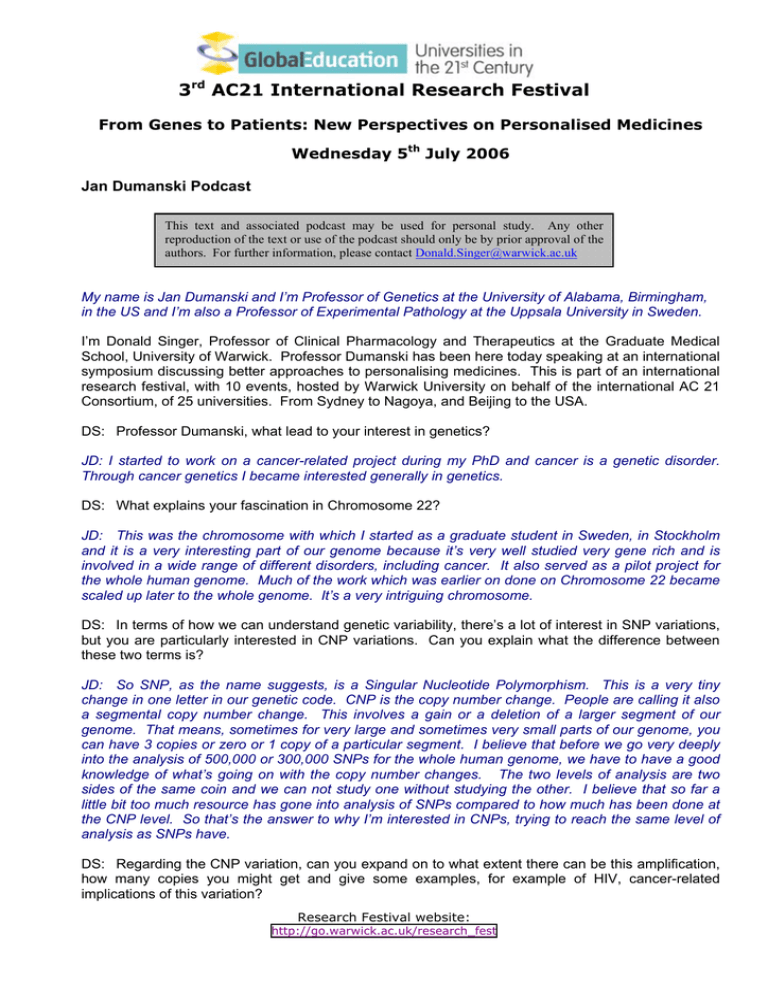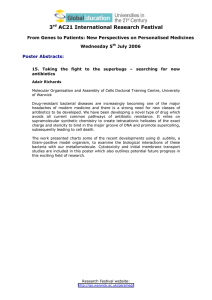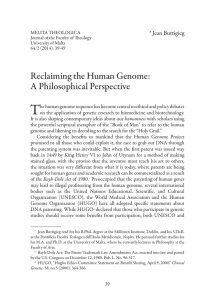3 AC21 International Research Festival
advertisement

3rd AC21 International Research Festival From Genes to Patients: New Perspectives on Personalised Medicines Wednesday 5th July 2006 Jan Dumanski Podcast This text and associated podcast may be used for personal study. Any other reproduction of the text or use of the podcast should only be by prior approval of the authors. For further information, please contact Donald.Singer@warwick.ac.uk My name is Jan Dumanski and I’m Professor of Genetics at the University of Alabama, Birmingham, in the US and I’m also a Professor of Experimental Pathology at the Uppsala University in Sweden. I’m Donald Singer, Professor of Clinical Pharmacology and Therapeutics at the Graduate Medical School, University of Warwick. Professor Dumanski has been here today speaking at an international symposium discussing better approaches to personalising medicines. This is part of an international research festival, with 10 events, hosted by Warwick University on behalf of the international AC 21 Consortium, of 25 universities. From Sydney to Nagoya, and Beijing to the USA. DS: Professor Dumanski, what lead to your interest in genetics? JD: I started to work on a cancer-related project during my PhD and cancer is a genetic disorder. Through cancer genetics I became interested generally in genetics. DS: What explains your fascination in Chromosome 22? JD: This was the chromosome with which I started as a graduate student in Sweden, in Stockholm and it is a very interesting part of our genome because it’s very well studied very gene rich and is involved in a wide range of different disorders, including cancer. It also served as a pilot project for the whole human genome. Much of the work which was earlier on done on Chromosome 22 became scaled up later to the whole genome. It’s a very intriguing chromosome. DS: In terms of how we can understand genetic variability, there’s a lot of interest in SNP variations, but you are particularly interested in CNP variations. Can you explain what the difference between these two terms is? JD: So SNP, as the name suggests, is a Singular Nucleotide Polymorphism. This is a very tiny change in one letter in our genetic code. CNP is the copy number change. People are calling it also a segmental copy number change. This involves a gain or a deletion of a larger segment of our genome. That means, sometimes for very large and sometimes very small parts of our genome, you can have 3 copies or zero or 1 copy of a particular segment. I believe that before we go very deeply into the analysis of 500,000 or 300,000 SNPs for the whole human genome, we have to have a good knowledge of what’s going on with the copy number changes. The two levels of analysis are two sides of the same coin and we can not study one without studying the other. I believe that so far a little bit too much resource has gone into analysis of SNPs compared to how much has been done at the CNP level. So that’s the answer to why I’m interested in CNPs, trying to reach the same level of analysis as SNPs have. DS: Regarding the CNP variation, can you expand on to what extent there can be this amplification, how many copies you might get and give some examples, for example of HIV, cancer-related implications of this variation? Research Festival website: http://go.warwick.ac.uk/research_fest 3rd AC21 International Research Festival JD: It very much depends on what we’re looking at, whether, for example, we are looking at the normal DNA, the normal human genome from the normal cells, or are we looking at the genome of a cancer cell. In the normal human genome, we have so far not seen changes which go beyond 4 copies of a certain locus or zero copies of a certain locus. But, when we are looking at the cancer cells, amplifications exceeding 10 copies are frequent and you can see them very easily. Thich is an illustration of a genetic de-regulation of the cancer cell. DS: In relation to HIV and over- or under-availability of these copies, is there any important significance for this? JD: Yes, so one of the very good examples of the involvement of the copy number changes in a human disorder, is the susceptibility or protection against the HIV infection, involving either receptor CCR5, receptor gene copy number, or the copy number of the ligand, which means the molecule that is binding to that receptor, which can be present up to 20 copies in a T-cell. The importance of this is that in order to develop efficient vaccines against HIV for instance, we have to know what is the genotype of the person who is vaccinated with the drug, because the effect depending on the genotype might be totally different. If you are protected you will see a very poor response to a good vaccine and vice-versa. So genotype information is very important, for instance, for the development of efficient HIV vaccines. DS: Are there any particular cancers where there’s information known about deletions being important in families where there’s increased risk of cancer? JD: There is a large number of different tumour syndromes which are pre-disposing for cancers. This pre-disposition is usually mediated by a deletion of a tumour suppressor gene, which is predisposing for that disorder. The technology which we are using today when we are analysing the whole human genome on a single chip, would lead to a very rapid identification of most of today’s known tumour suppressor genes or growth genes. This illustrates the power of the method. So, cancer is one of the areas where deletions or amplifications are very important and we should say here, that the finding and characterisation of these aberrations is providing an opportunity for the development of new drugs. An instance is the very successful story of Gleevec (imatinib mesylate), a drug which targets the activated Bcr-Abl tyrosine kinase gene. [Imatinib mesylate specifically inhibits the proliferation of Bcr-Abl-expressing cells and thus is a prime example of gene product targeted therapy, in this case of value in the treatment of the white blood cell cancer chronic myelogenous leukemia]. Similar drugs might be developed towards the blocking of the receptors of other molecules which are amplified, for instance, in cancer cells. Study of the amplifications and deletions in both normal and cancer cells is very important knowledge. DS: Finally, what are the practical and economic implications of taking this technology from the lab into the clinic? JD: These techniques are usually very costly. Whichever technique we are using today, the costs are considerable and one of the goals is to decrease these costs dramatically so that we can apply these analyses in diagnostics, but also for more efficient drug discovery. The goal is to reduce the costs by 10-fold compared to the current costs involved in these studies. DS: Thank you very much Professor Dumanski. JD: Thank you very much. Research Festival website: http://go.warwick.ac.uk/research_fest







